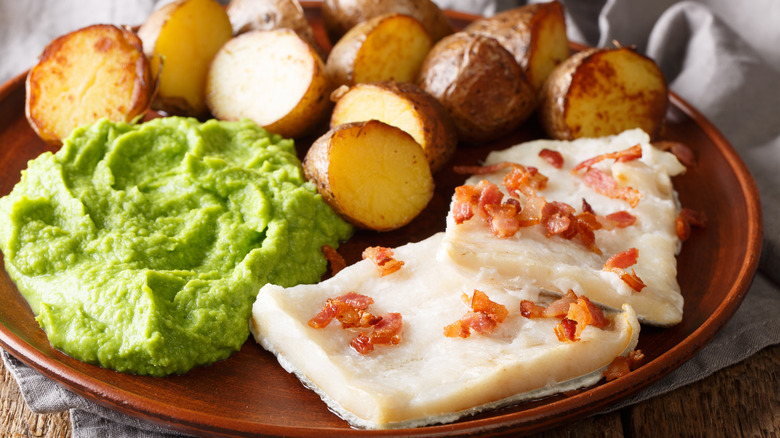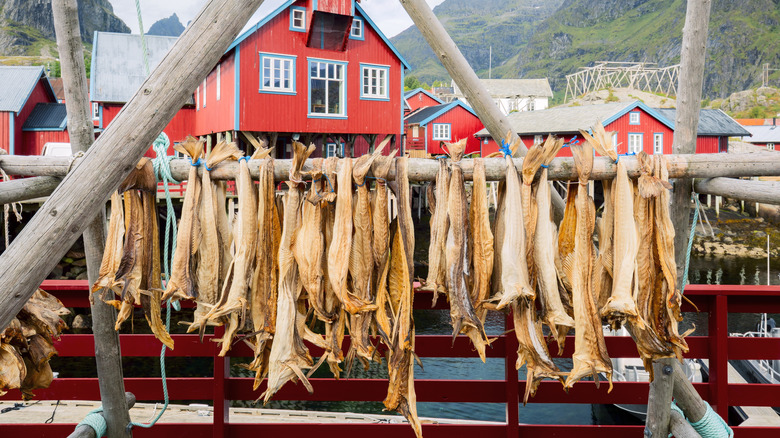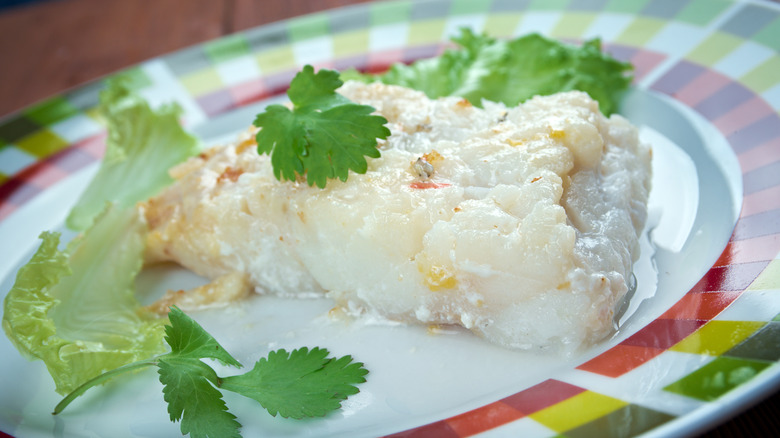Everything You Need To Know About Lutefisk
Lutefisk is just one of those foods. You know the kind: the almost mythical ones that polarize on contact, that create factions so deeply divided, neither can conceive of the other's position. Limburger cheese, souse, and liver belong to this unique class. You either get it or you most-assuredly don't.
To some, Lutefisk is a punchline, synonymous with gut-wrenching culinary revulsion and repugnance. Yet, it is altogether likely that those same people who claim to be disgusted by lutefisk have little-to-no understanding of what it is, why it exists, and why some truly enjoy it.
Many people's entire knowledge of lutefisk begins and ends at its appearance. It's safe to say it isn't winning any beauty contests. It boasts a milky pallor, gelatinous structure, and proclivity for jiggling, according to The Daily Meal. These are hallmarks, though, of the history of a food that has a long and storied past.
From stockfish to lutefisk
Dried fish really deserves a moment, if not for its flavor and versatility, then for its service to humanity. As History Today points out, stockfish has been a vital source of sustenance since the age of Vikings. It is fish, largely cod, dried on large racks in the cold, dry Scandinavian air. The process transforms the fish from a delicate, highly-perishable meat to one that can withstand long sea voyages and sustain communities when food is scarce.
Stockfish, though, is more of a means of preservation. You would no sooner eat it straight than you would a handful of chopped spinach direct from the freezer. Stockfish — like its heavily-salted cousin known variously as bacalao, baccala, or simply salt cod — must be rehydrated carefully before it is fit for consumption (via Alpha Foodie).
Once rehydrated, stockfish can be used in a variety of ways, from fragrant stews to an elegant fried preparation. But one of the most enduring methods of reconstituting stockfish is making lutefisk.
Much like all other stockfish, lutefisk begins its life cycle with a long soak in water which is changed every day, explains the Nordic Recipe Archive. This is followed by a soak in a mixture of lye — lutefisk means "lye fish" in Norwegian — which gives the fish its famed gelatinous quality. Because lye is not something you want to consume, as it is extremely caustic, lutefisk must again be soaked in regularly-changed baths of water to draw out the alkaline substance.
Gelatinous goodness
Once the lengthy soaking process is complete, lutefisk is finally ready for cooking. Jiggly mouthfeel aside, lutefisk is a mild protein and doesn't lend itself to much variety in the kitchen. One general rule, though, which holds true across recipes, is the need to keep the cooking method gentle as lutefisk has a delicate constitution.
Norway Today offers a plethora of facts about lutefisk, including an apocryphal, but amusing legend that states that a significant number of Norwegian expats left the country to get away from lutefisk, while an equal number traveled forth to share its goodness with the world. Regardless, the traditional Norwegian treatment sees lutefisk either steamed or baked, its mildness complemented by either cream sauce or copious amounts of butter along with bacon, boiled potatoes, and mashed or stewed peas.
An interesting note, especially given the Scandinavian heritage of lutefisk, is that, according to NPR, it's not really all that popular in the land of its origin. While it was once a food of necessity, modern access to, well, nearly everything has dimmed lutefisk's luster. But in the parts of the U.S. where Norwegians, Swedes, and other Scandinavians settled, such as the upper midwestern states of Minnesota and North Dakota, lutefisk holds a special place. Though it may not be thoroughly beloved, this squishy, wiggly fish that is treated with a highly-toxic chemical is a proud sign of one's heritage.


